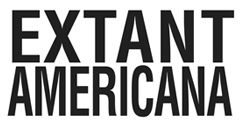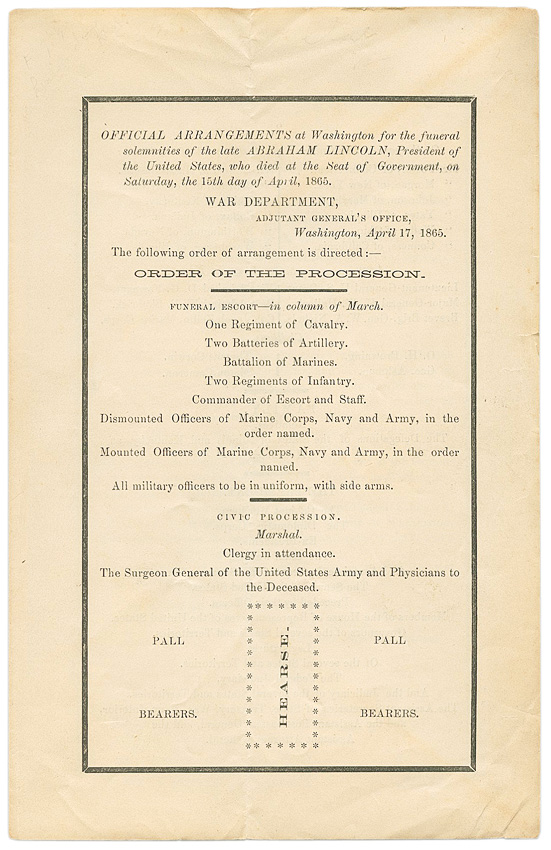
(Abraham LINCOLN) Printed circular, 3pp. octavo (8 x 5 in.) Washington, 17 April 1865, headed “OFFICIAL ARRANGEMENTS at Washington for the funeral solemnities of the late ABRAHAM LINCOLN, President of the United States, who died at the Seat of Government, on Saturday, the 15th day of April, 1865.” Issued by the War Department, this original printing presents the “ORDER OF THE PROCESSION” for the funeral procession that took place two days later, on 19 April 1865. The procession was headed by a full military escort and the “CIVIC PROCESSION” which was headed by the Marshal, “Clergy in attendance” and just before the hearse “The Surgeon General of the United States army and Physicians to the Deceased.” Members of the House and Senate followed Lincoln’s hearse together with representatives of the Army and Navy. Following was the “FAMILY” together with delegations from Kentucky and Illinois followed by President Andrew Johnson, the cabinet, diplomatic corps, former presidents and so forth. Housed in a custom slipcase in 3/4 blue cloth and titled leather spine.
Third page bears a very small loss at top center, slight toning to first page, minor marginal wear, else fine condition.
(EXA 3906) $1,250

(Abraham Lincoln) Scarce broadside, 4 3/4 x 6 in. headed “NOTICE” (Pottstown, [Penn.], 18 April 1865). An announcement of a memorial service to be held in honor of the recently slain Lincoln: “Agreeably to the request of the Acting Secretary of State, there will be RELIGIOUS SERVICES IN THE German Reformed Church, ON WEDNESDAY, AT 12 M., To commemorate the untimely death of the President of the United States. The members of the congregation, and the public generally, are invited to attend. By order of the CONSISTORY.”
Fine condition. Simply matted in a period frame.
(EXA 4278) $750
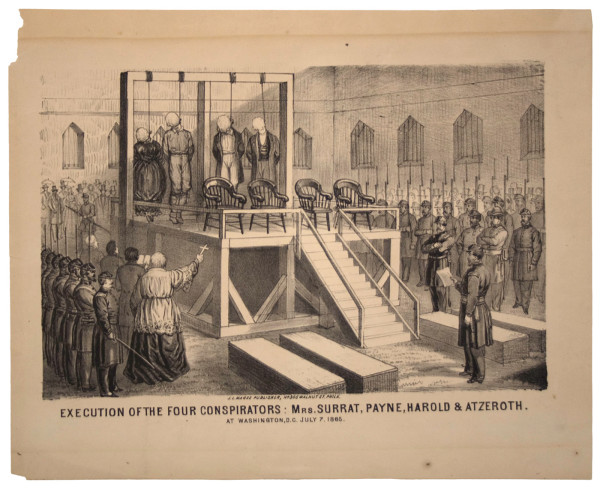
(Abraham Lincoln) Lithograph, Execution of the four conspirators: Mrs. Surrat [sic], Payne, Harold & Atzeroth. At Washington, D.C., July 7, 1865. (Philadelphia, J.L. Magee, 1865.) 7 3/4 x 11 3/4 in. on a 11 x 13 5/8 in. sheet. The artist has taken some liberties in depicting the scene. A priest is shown prominently aside the gallows, as Mary Surratt’s Catholicism was a prominent subject in the press. A niece clean example.
Minor marginal losses well clear of image, else fine condition. Matted and ready for framing.
(EXA 3897) $500
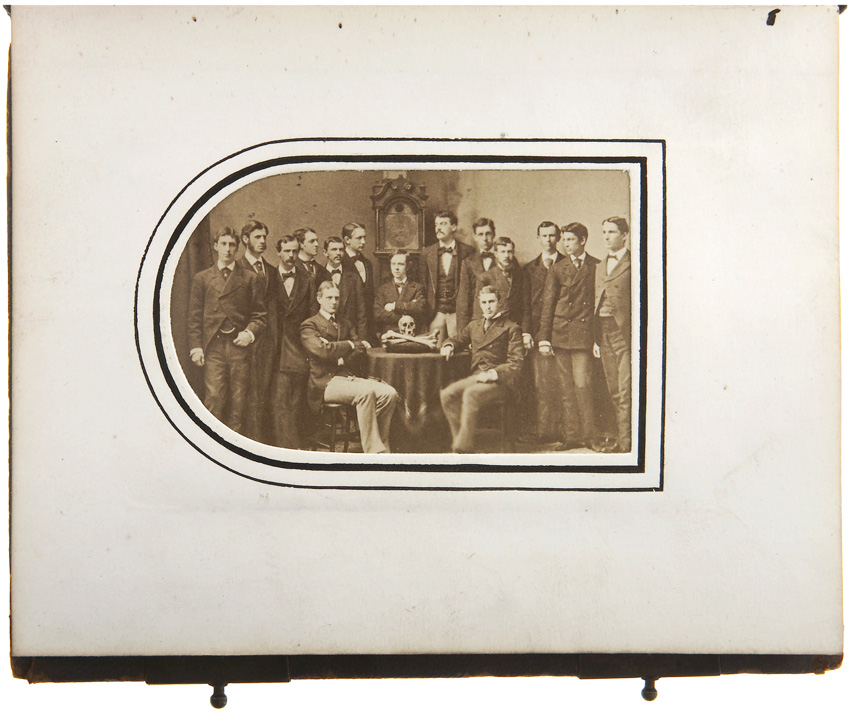
(Skull & Bones Society) A superb collection related to the infamous Yale secret society that counts several presidents together with top diplomats and financiers among its alumni. The group features a gold Skull and Bones lapel pin together with a leather-bound photograph album bearing cartes de visite of its members from the class of 1872.
The collection, from Edward T. Owen, a member of the class of 1872 includes his gold lapel pin with the skull emblem on top (the crossed bones over the number “322”, measuring 3/4 in. width with a hinged straight pinback. The reverse is engraved “E. T. Owen”. Owen’s pin is accompanied by a leather-bound photo album containing eighteen cartes de visite one of each of the members of the class of 1872, a group image posed with the skull & bones, the skull & bones alone, as well as an image of the society’s home, “The Tomb.” The collection also includes five additional cartes of Skull & Bones members not part of the Class of 1872.
Edward Thomas Owen entered Yale University with the class of 1871 and joined the class of 1872 at the beginning of his senior year. After graduation Owen studied two years at the Georg-August-Universität Göttingen in Germany and a year in Paris. He returned to the United States as a professor of French and Linguistics at the University of Wisconsin. Owen, with the Mutton Chops facial hair, is pictured wearing this pin. The roster of the Skull and Bones Class of 1872 records only fourteen members; however, there are fifteen cartes de visite in the members section of the album and an equal number in the group image. In addition to Owen the other Bonesmen in 1872 were: Robert Elmer Coe, who died shortly after graduation in 1872 of typhoid fever; William Lee Cushing who taught at Yale and founded the Westminster School in Dobbs Ferry, New York; Charles Clerc Deming, who, after graduating from Columbia Law School, became vice president of the Jacksonville, Tampa, and Key West Railway Company; Henry Champion Deming, secretary and treasurer for the Mercantile Trust Company of New York; Frederic Shepard Dennis, a professor of surgery at Bellevue Medical College; John Howard Hincks, an ordained minister who served as dean of Atlanta University and professor of History and Social Science; Benjamin Hoppin, a German translator; Alexander Ross Merriam, a pastor; George Foot Moore, also a pastor; Henry Silas Payson, who practiced law in St. Louis, before he retired to Payson Farms at Mossville, Illinois; Charles Benjamin Ramsdell, who graduated from Union Theological Seminary and became a pastor; George Atherton Spalding a physician at the House of Refuge, Randall’s Island, New York; and, Theodore Salisbury Woolsey a professor of law at Yale Law School.
Cartes and pin quite clean, expected wear to binding of photographs, overall very fine.
(EXA 3881) SOLD.

William Howard TAFT (1857 – 1930) Fine content Autograph Letter Signed “Wm H. Taft” as President, 1p. 8 3/4 x 7 in. on White House letterhead, Washington, 26 June 1912 to “Dear Mr. Glaser” regretting his inability “… to be present at the Ratification Banquet on Saturday Evening next. It would be a great pleasure to rejoice with you and my many friends over the recent victory for constitutional government that was won at Chicago. I am very hopeful of the result in November, but whatever happens we have fought a good fight for the country’s sake already and have won.”
Only days before Taft wrote to Glaser, the Republican National Convention had nominated him to run for a second term as President. Taft’s victory in Chicago was marred by the defection of Theodore Roosevelt, who challenged Taft for the nomination. Roosevelt had come to the convention holding the majority of delegates chosen in the primaries, but Taft managed to secure most of the uncommitted delegates to secure the Republican nod. In protest, Roosevelt, bolted from the party to run as the independent “Bull Moose.” In the ensuing general election, Taft and Roosevelt split the Republican vote allowing Woodrow Wilson’s victory in November.
Taft was a champion of the Sixteenth Amendment which granted Congress the right to enact a federal income tax: hence his reference to a “Ratification Banquet”. Taft proposed the amendment on 16 June 1909 in an address to Congress in which he requested passage of a 2% federal income tax on corporations together with the amendment that would give it constitutional legitimacy. The amendment, which was characterized by its opponents as an attack on state’s rights, took nearly four years to pass. At the time of Taft’s writing, only 33 states had approved the amendment, and three were still needed to secure ratification. Ratification came on 3 February, 1913 when Delaware approved the measure.
Light soiling, usual folds, else very good condition.
(EXA 3868) SOLD.

(Zachary TAYLOR) Broadside, “BY EXTRAORDINARY EXPRESS & TELEGRAPH FOR THE MINERS’ JOURNAL ONLY. GEN. TAYLOR’S INAUGURAL ADDRESS DELIVERED AT WASHINGTON, March 5th, at 12 O’clock, M. [Pottsville, Penn.] (24 x 7 1/4 in.).
Rare. An extremely early printing of Zachary Taylor’s brief inaugural address transcribed from the telegraph: “We have at considerable expense procured a Copy of Gen. Taylor’s Inaugural Address, by Telegraph in advance of our Contemporaries, and hasten to lay it before our readers.” An early telegraphic ‘scoop’ of the larger publications in the region as noted in the postscript notice at the bottom of the sheet: “IN ORDER to furnish our readers with Gen. Taylor’s Inaugural Address in advance of the Philadelphia papers, we have gone to much trouble and expense. Therefore those who purchase, we hope, will not loan it immediately.”
Creases, light wear to margins, else fine condition overall.
(EXA 3907) $1,500
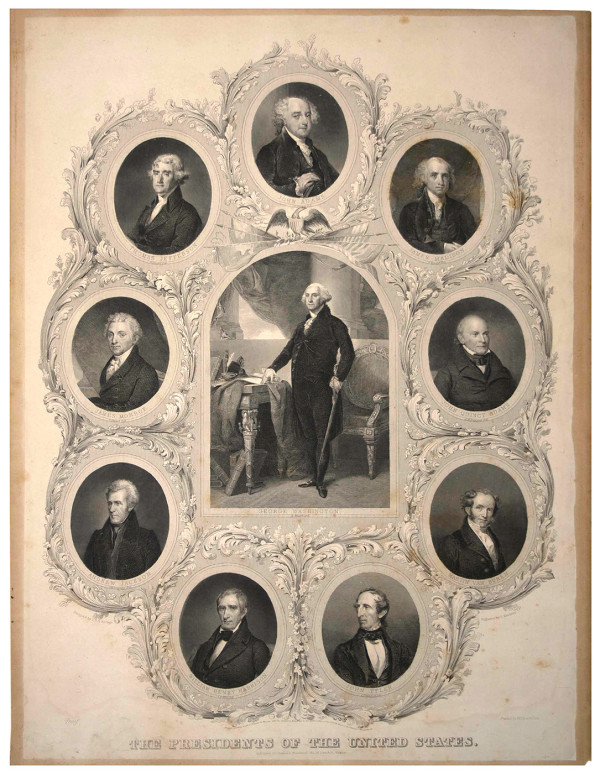
(Presidents of the United States) Engraving, “THE PRESIDENTS OF THE UNITED STATES” 18 1/2 x 13 1/2 in. (Boston: Charles A. Wakefield, 1842) Designed by C. H. H. Billings and engraved by D. Kimberly. A fine rendering of the first ten men to hold the office of the President including John Tyler. Tyler was often derided as the “Acting President” as he was the first vice president to succeed to the presidency (on the death of William Henry Harrison in 1841 after only a month in office).
Very light scattered foxing, affixed to a slightly larger sheet that is toned at margins but well clear of image, else very good.
(EXA 3884) $750
“I fear if Mr Madison is elected the war will last longer than I shall live and reduce many thousands to beggary…”


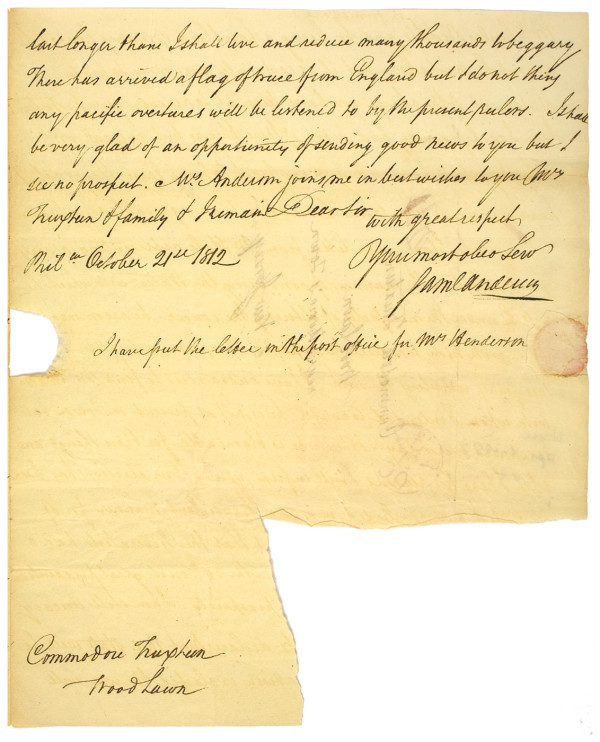
(War of 1812) Autograph Letter Signed,“Jame[s] Anderson”, 3pp., 9 3/4 x 8in. Philadelphia, 21 October 1812 to Thomas Truxtun (1755 – 1822) who commanded the USS Constellation during the Quasi-War with France gaining fame in his victory over l’Insurgente in 1800.
Our correspondent updates Truxtun on a convoluted real estate matter involving water rights and neighboring lands (including some owned by Clement Biddle, then moves on to politics, bemoaning the likely victory of James Madison – an irksome prospect for Federalists everywhere now that war with Britain had begun: “Our election has been conducted and concluded in a very fraudulent manner for of real voters there is not a doubt but that the Federalists had a majority but for the grand object on the 30th inst great precaution will be used and we fully expect prosperity. I am still uneasy about Jersey for the Democrats declare that the state will be for Madison – I fear if Mr Madison is elected the war will last longer than I shall live and reduce many thousands to beggary. There has arrived a flag of truce from England but I do not think any pacific overtures will be listened to by the present Rulers. I shall be very glad of an opportunity of sending good news to you but I see no prospect.” New Jersey did go for DeWitt Clinton, contrary to our correspondent’s fears, but Pennsylvania went to Madison despite the Federalists’ “great precaution”.
The War of 1812 did make the Federalists, already in political decline, very defensive and suspicious of Democratic methods.The Federalist press of the period abounded in rumors of electoral fraud and intimidation and even “threats of assassination and murder … against all those who dare to oppose President Madison’s election.”1
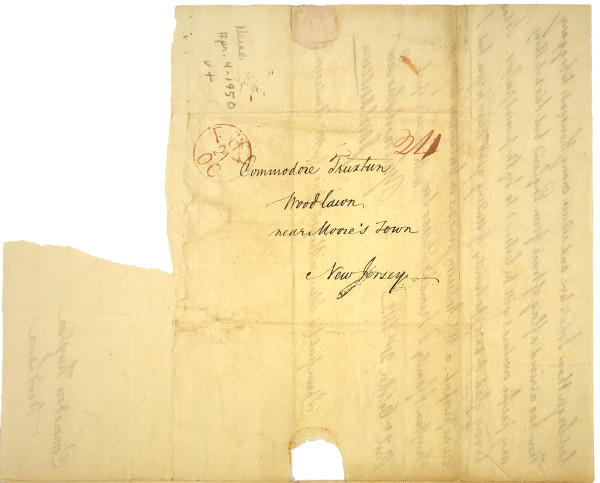
Integral transmittal leaf addressed to “Commodore Truxtun Woodlawn near Moore’s town New Jersey” and bears a red “PHA 21 OC” cancellation and red ink “24” at right.
Loss to second leaf from seal tear and again at bottom right (quite deliberately but not affecting text), usual folds, else very good condition.
(EXA 4090) $500
______________________
1 Salem Gazette, 20 Oct. 1812, 2.

(George WASHINGTON) A scarce 12 1/2 x 10 3/4 in. glazed-cotton kerchief printed in blue entitled “THE LOVE OF TRUTH MARK THE BOY.” Printed circa 1806 by the Germantown Print Works who also produced the more commonly seen kerchief, “The effect of principle Behold the Man” that was produced around the same period.
The present example retells, in verse, the apocryphal story of George Washington and the cherry tree that first appeared in Mason Locke Weems’ 1800 celebratory biography, A History of the Life and Death, Virtues and Exploits of General George Washington. The illustration at top is wonderfully anachronistic (we don’t recall top hats to be in fashion in the 1730s) – yet very typical of the first decade of the nineteenth century.
Scarce. Listed as No. 39 in Threads of History.
Some scattered light staining not detracting, very light folds and minor.
(EXA 4060) $750

(John Trumbull) Hand colored engraving, “George Washington : On the Great Occasion of Our Presidential Election. To All Lovers of Freedom and Independence,: Is Presented this Portrait. “‘The Father of Our Country.’” 10 1/8 x 9 1/2 in on a 16 1/2 x 11 in. sheet, ([New York: Illman & Son, c. 1848]).
Light toning at top center, light marginal wear, else fine.
(EXA 3883) $475













